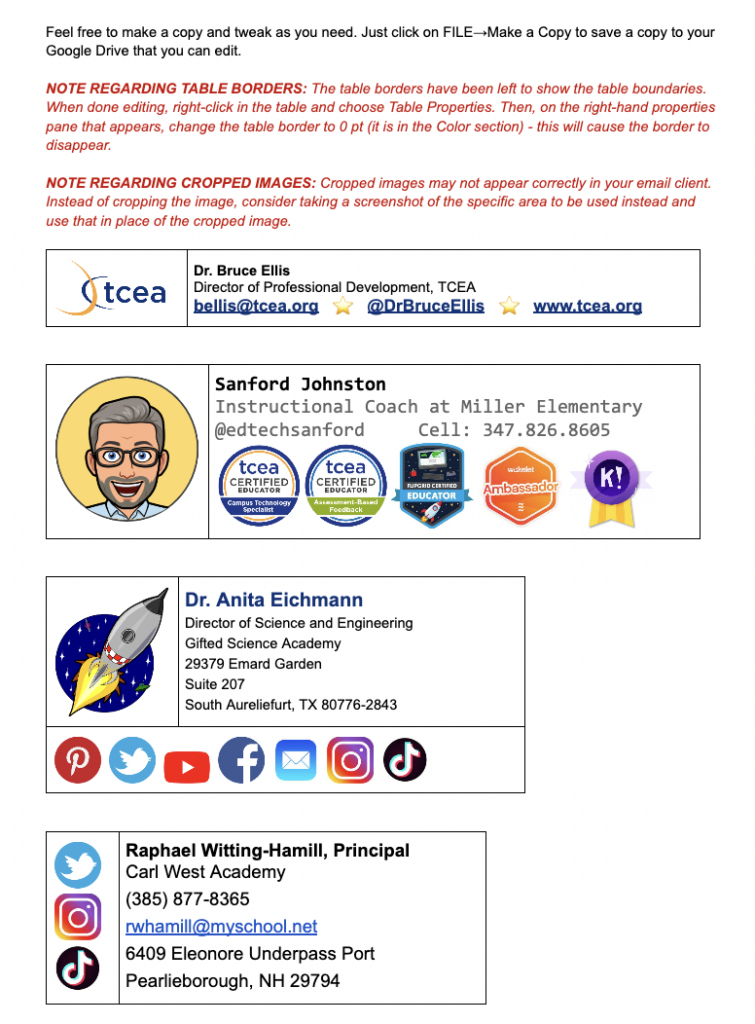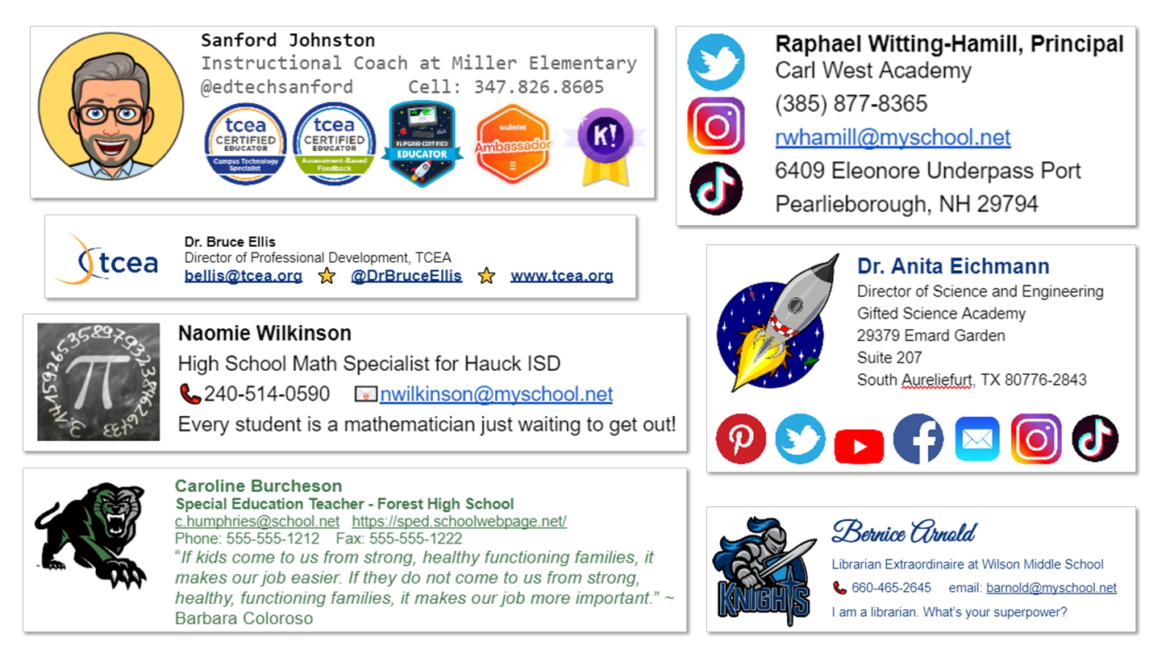Email signatures are an important tool to communicate how recipients can best contact you (other than email). But they can also be used to communicate your areas of expertise. You have probably seen some email signatures that are well designed, and you’ve probably seen a few that aren’t. Read further to find out how you can create an amazing email signature that is effective AND simple to design. Think of your signature as a well-dressed messenger that represents you!
Six Tips for Email Signature Content
- Provide your contact information. The email signature is meant to contain the basics of how others can contact you. For example, if you are in a leadership position, it should contain your full name, email address, and phone number at the least.
- Promote your campus and district. Many times a signature can promote your district, department, or campus look and feel by using a logo and designated color scheme.
- Keep it short. As you are putting together your signature, try to keep it as condensed as possible. The rule of thumb is to have it take up no more than five lines.
- Scale down those graphics. When you add a graphic, you may need to scale it down so that the signature stays compact. Preview the signature to make sure any graphics are properly sized.
- Share info about special projects, events, or something you’re up to. Tweaking your signature is great to do when there are times you want to promote something that you’re doing or share something special– like the current book you’re reading, a special event that’s coming up, or an inspirational quote.
- Customize signatures for new emails and replies/forwards. Your email client may have two signature settings– one for new emails and one for replies/forwards. Consider doing a more elaborate signature as the default for new emails and a more streamlined signature as the default for replies and forwards.
Email Signature Content to Include
Though you don’t want your signature to be obnoxious, you also don’t want it to be bland. Adding visual interest to your signature can help it (and you) stand out. Here are a few ideas to consider adding. Note that I’m not suggesting you add ALL of these items (see tip number three above!).
- Bitmoji or headshot
- Your name and title
- Department or campus of where you work
- Phone and/or fax number
- Address (and link to online directions)
- Social media icons (each linked to your social media presence)
- School/district mascot
- Inspirational quote or quote related to your field of expertise
- Digital badges showing your areas of expertise
How to Create an Email Signature
We’ll design a nice, compelling signature by putting together the elements in Google Docs. We can then copy/paste them into Gmail or Outlook. Just follow these easy steps to begin putting together your signature.

- Go to Docs.new to start a new Google Doc. If you’d prefer, feel free to use our Signature Templates file – just click on File–>Make a Copy to save a copy that you can edit to your Google Drive.
- Insert a table that consists of one row with two columns. This allows for a logo to be in the left cell and your other information in the right-hand cell.
- Insert an image in the left-hand cell. With the image selected, click and drag on one of the corner handles to resize it to an appropriate size.
NOTE REGARDING CROPPED IMAGES: Cropped images may not appear correctly in your email client. Instead of cropping the image, consider taking a screenshot of the specific area to be used instead and use that in place of the cropped image. - Click and drag the vertical cell divider to move over close to the logo.
- Begin entering your information in the right-hand cell.
- To add links to the specific text, you will need to do the following:
- Highlight the text to be made into a link
- Click on Insert–>Link
- Paste the URL in the entry area and click Apply. If you type the URL in the box, be sure to begin it with http:// or https://.
- If you want your text or links to match a specific color in your logo, then consider using a Chrome extension ColorPick Eyedropper. To use the extension, just do the following:
- Click on the extension. A pixelated grid will appear helping you designate precisely where you want to select.
- Click n the specific spot.
- A small dialog box will appear with the hexadecimal code and the rgb code of the spot.
- Copy the hexadecimal six-digit code.
- Highlight the text to color.
- Click on the Text Color icon and click the small plus symbol to add the color to the palette.
- Paste the six-digit code in the box. You should notice that the color picker adjusts to identify the color you chose.
- Click OK.
- When you are done editing the information in your signature, it is important that you hide the table border. To do so, click on the table, and then select Format–>Table–>Table Properties. A properties pane appears on the right-hand side of the window. In the Color section, set the table border to 0 pt.
- Now it is time to highlight the contents of both cells. If you find that you are selecting the image when you try to click and drag from left to right, try clicking and dragging from right to left. Once the cell contents are highlighted, click on Edit–> Copy. You are now ready to paste in the signature settings of your email client.
How to Change Your Email Signature Settings
For Gmail, follow these steps:
- Open Gmail.
- Click on the gear icon (upper right) and select See all settings.
- In the General tab, scroll down to the Signature section.
- Click the Create new button and give your signature a name.
- Paste the cell contents into the signature area where the cursor appears.
- Edit the signature defaults to show the named signature for new emails and/or on reply/forward emails.
- Scroll to the bottom of the page and click Save Changes.
For Outlook 365, follow these steps:
- Click on View–> View Settings. TIP: If you do not see View Settings, you will need to add it to the menu by clicking on the more icon (three dots at the right of the menu items) and choosing Customize. Look for the View Settings button; enable it. Click Save.
- In the Mail settings, click on the Compose and Reply section.
- Click the New signature link.
- Give your signature a name.
- Paste the contents of the table in the editable section.
- Select it as the default signature for new and/or replies/forwards messages. If you do not see the named signature in the list, click the Save button then click the dropdown again to select the default signature.
- Click the Save button.
- Close the Settings dialog box.
What Will You Create?
Your email signature is a reflection of who you. It’s like a digital business card. How will you design yours? What will you include so that others will want to interact with you? We would love to know what you design! Share in the comments.


8 comments
Can I add one more strategy to what you have begun here?
Consider accessibility when designing these — use alt text or type in text in lieu of making all information graphics-only. That way, for those who need computers to read text aloud to them (non-readers, those with visual impairments) can access information. As America continues to age, you will help more people than you think!
Great point, Kristin. Thanks for reminding us.
Great point about watching out for cropped images. And I love the part of using the signature to share information about upcoming events, presentations etc.
Another aspect to consider is the actual file size of any image used. I have seen email signatures with high-res images that add hundreds of KB to the message. An email thread with multiple such messages ends up being multiple MB in size that fills up inboxes. Watch for high-res images in email signatures adding to message bloat.
Thanks for the extra points you made, Harshal. Those are definitely helpful and relevant!
Very helpful. The end of the Video does not show how to add to email client.
I’m glad you found it helpful, Sarah. You are correct, I didn’t demo in the video how to add it to your email client in order to keep the video from getting much longer. Directions to add it to your email client (Gmail or Outlook) are outlined in the steps below the video. Here is a brief video to demonstrate adding a signature to Gmail.
When I try to add it to my Gmail it says it is too long. Any ideas on how to fix that?
Hi Kristen! Thanks for reaching out. Unfortunately, Gmail is pretty strict on how long email signatures can be. Your best bet is to keep your signature short and sweet. Do you know how many characters over the limit the signature you’re trying to add is? If so, I may be able to help you shorten it. Feel free to email me at mhall@tcea.org.